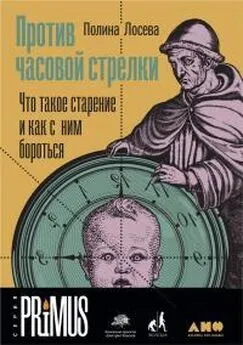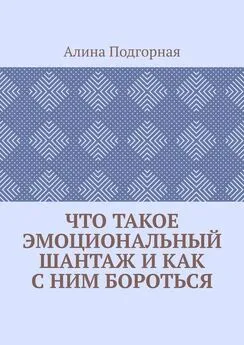Полина Лосева - Против часовой стрелки. Что такое старение и как с ним бороться
- Название:Против часовой стрелки. Что такое старение и как с ним бороться
- Автор:
- Жанр:
- Издательство:Альпина нон-фикшн
- Год:2020
- Город:Москва
- ISBN:978-5-0013-9314-6
- Рейтинг:
- Избранное:Добавить в избранное
-
Отзывы:
-
Ваша оценка:
Полина Лосева - Против часовой стрелки. Что такое старение и как с ним бороться краткое содержание
В своей книге биолог и научный журналист Полина Лосева выступает в роли адвоката современной науки о старении и рассказывает о том, чем сегодня занимаются геронтологи и как правильно интерпретировать полученные ими результаты. Кто виноват в том, что мы стареем? Что может стать нашей защитой от старости: теломераза или антиоксиданты, гормоны или диеты? Биологи пока не пришли к единому ответу на эти вопросы, и читателю, если он решится перейти от размышлений к действиям, предстоит сделать собственный выбор.
Эта книга станет путеводителем по современным теориям старения не только для биологов, но и для всех, кому интересно, как помочь своему телу вести неравную борьбу со временем.
Против часовой стрелки. Что такое старение и как с ним бороться - читать онлайн бесплатно ознакомительный отрывок
Интервал:
Закладка:
374
Dominy S. S. et al. Porphyromonas gingivalis in Alzheimer's disease brains: Evidence for disease causation and treatment with small-molecule inhibitors // Science Advances. 2019 Jan; 5 (1): eaau3333.
375
Ezzat K. et al. The viral protein corona directs viral pathogenesis and amyloid aggregation // Nature Communications. 2019 May; 10: 2331.
376
Griffen A. L. et al. Prevalence of Porphyromonas gingivalis and periodontal health status // Journal of Clinical Microbiology. 1998 Nov; 36 (11): 3239–3242.
377
Human Herpesviruses. Cambridge University Press, 2007.
378
Бредесен Д. Нестареющий мозг. – М.: Эксмо, 2019.
379
Bredesen D. E. et al. Reversal of cognitive decline: 100 patients // Journal of Alzheimer's disease & Parkinsonism. 2018; 8: 5.
380
См. п. 93.
381
Livshits G. & Kalinkovich A. Inflammaging as a common ground for the development and maintenance of sarcopenia, obesity, cardiomyopathy and dysbiosis // Ageing Research Reviews. 2019 Dec; 56: 100980.
382
Melzer D. et al. The Age UK almanac of disease profiles in later life. Ageing Research Group, University of Exceter, 2015.
383
Dengler-Crish C. M. & Elefteriou F. Shared mechanisms: osteoporosis and Alzheimer's disease? // Aging. 2019 Feb; 11 (5): 1317–1318.
384
Belikov A. V. Age-related diseases as vicious cycles // Ageing Research Reviews. 2019 Jan; 49: 11–26.
385
Franceschi C. et al. Immunosenescence in humans: deterioration or remodelling? // International Reviews of Immunology. 1995; 12 (1): 57–74.
386
Levine M. E. Modeling the Rate of Senescence: Can Estimated Biological Age Predict Mortality More Accurately Than Chronological Age? // The Journals of Gerontology: Series. 2013 Jun; 68 (6): 667–674.
387
Jylhävä J., Pedersen N. L., Hägg S. Biological age predictors // EBioMedicine. 2017 Jul; 21: 29–36.
388
Fried L. P. et al. Frailty in older adults: evidence for a phenotype // The Journals of Gerontology: Series A. 2001 Mar; 56 (3): M146–M157.
389
Jazwinski S. M. & Kim S. Metabolic and genetic markers of biological age // Frontiers in Genetics. 2017 May; 8: 64.
390
Williams D. M., Jylhävä J., Pedersen N. L., Hägg S. A frailty index for UK Biobank participants // The Journals of Gerontology: Series A. 2019 Apr; 74 (4): 582–587.
391
Mitniski A. et al. Age-related frailty and its association with biological markers of ageing // BMC Medicine. 2015 Jul; 13: 161.
392
Jylhävä J., Jiang M., Foebel A. D., Pedersen N. L., Hägg S. Can markers of biological age predict dependency in old age? // Biogerontology. 2019 Jan; 20: 321–329.
393
Belsky D. W. et al. Quantification of biological aging in young adults // PNAS. 2015 Jul; 112 (30): E4104–E4110.
394
Bobrov E. et al. PhotoAgeClock: deep learning algorithms for development of non-invasive visual biomarkers of aging // Aging. 2018 Nov; 10 (11): 3249–3259.
395
Mamoshina P. et al. Population specific biomarkers of human aging: a big data study using south korean, canadian, and eastern european patient populations // The Journals of Gerontology: Series A. 2018 Nov; 73 (11): 1482–1490.
396
Galkin F. et al. Human microbiome aging clocks based on deep learning and tandem of permutation feature importance and accumulated local effects // bioRxiv. 2018 Dec.
397
Lai T.-P., Wright W. E., Shay J. W. Comparison of telomere length measurement methods // Philosophical Transactions of the Royal Society B. 2018 Mar; 373 (1741): 20160451.
398
См. п. 242.
399
Alder J. K. et al. Diagnostic utility of telomere length testing in a hospital-based setting // PNAS. 2018 Mar; 115 (10): E2358–E2365.
400
Mather K. A., Jorm A. F., Parslow R. A., Christensen H. Is telomere length a biomarker of aging? A review // The Journals of Gerontology: Series A. 2011 Feb; 66A (2): 202–213.
401
Lakota K. et al. Short lymphocyte, but not granulocyte, telomere length in a subset of patients with systemic sclerosis // Annals of the Rheumatic Diseases. 2019 Jan; 78: 1142–1144.
402
Aviv A. & Shay J. W. Reflections on telomere dynamics and ageing-related diseases in humans // Philosophical Transactions of the Royal Society B. 2018 Mar; 373 (1741): 20160436.
403
Eisenberg D. T. A. & Kuzawa C. W. The paternal age at conception effect on offspring telomere length: mechanistic, comparative and adaptive perspective // Philosophical Transactions of the Royal Society B. 2018 Mar; 373 (1741): 20160442.
404
Müezzinler A., Zaineddin A. K., Brenner H. A systematic review of leukocyte telomere length and age in adults // Ageing Research Reviews. 2013 Mar; 12 (2): 509–519.
405
Frenck R. W., Blackburn E. H., Shannon K. M. The rate of telomere sequence loss in human leukocytes varies with age // PNAS. 1998 May; 95 (10): 5607–5610.
406
Dugdale H. L. & Richardson D. S. Heritability of telomere variation: it is all about the environment! // Philosophical Transactions of the Royal Society B. 2018 Mar; 373 (1741): 2016.0450.
407
Bateson M. & Nettle D. The telomere lengthening conundrum – it could be biology // Aging Cell. 2016 Dec; 16 (2): 312–319.
408
Blackburn E. H., Espel E. S., Lin J. Human telomere biology: A contributory and interactive factor in aging, disease risks, and protection // Science. 2015 Dec; 350 (6265): 1193–1198.
409
Garrett-Bakelman F. E. et al. The NASA Twins Study: A multidimensional analysis of a year-long human spaceflight // Science. 2019 Apr; 364 (6436): eaau8650.
410
Horvath S. & Raj K. DNA methylation-based biomarkers and the epigenetic clock theory of ageing // Nature Reviews Genetics. 2018 Apr; 19: 371–384.
411
Horvath S. DNA methylation age of human tissues and cell types // Genome Biology. 2013 Dec; 14: 3156.
412
Chen B. H. et al. DNA methylation-based measures of biological age: meta-analysis predicting time to death // Aging. 2016 Sep; 8 (9): 1844–1865.
413
Hannum G. et al. Genome-wide methylation profiles reveal quantitative views of human aging rates // Molecular Cell. 2013 Jan; 49 (2): 359–367.
414
См. п. 242.
415
Wi X. et al. DNA methylation profile is a quantitative measure of biological aging in children // Aging. 2019 Nov; 11 (22): 10031–10051.
416
Lu A. T. et al. DNA methylation GrimAge strongly predicts lifespan and healthspan // Aging. 2019 Jan; 11 (2): 303–327.
417
Levine M. E. et al. An epigenetic biomarker of aging for lifespan and healthspan // Aging. 2018 Apr; 10 (4): 573–591.
418
Teo Y. V. et al. Cell‐free DNA as a biomarker of aging // Aging Cell. 2018 Dec; 18 (1): e12890.
419
Miura Y. & Endo T. Glycomics and glycoproteomics focused on aging and age-related diseases – Glycans as a potential biomarker for physiological alterations // Biochimica et Biophysica Acta (BBA) – General Subjects. 2016 Aug; 1860 (8): 1608–1614.
420
Cole J. H. et al. Brain age predicts mortality // Molecular Psychiatry. 2017 Apr; 23: 1385–1392.
421
Goyal M. S. et al. Persistent metabolic youth in the aging female brain // PNAS. 2019 Feb; 116 (8): 3251–3255.
422
См. п. 242.
423
Kim S., Myers L., Wyckoff J., Cherry K. E., Jazwinski S. M. The frailty index outperforms DNA methylation age and its derivatives as an indicator of biological age // GeroScience. 2017 Jan; 39: 83–92.
424
Belsky D. W. et al. Eleven telomere, epigenetic clock, and biomarker-composite quantifications of biological aging: do they measure the same thing? // American Journal of Epidemiology. 2018 Jun; 187 (6): 1220–1230.
425
Søraas A. et al. Epigenetic age is a cell‐intrinsic property in transplanted human hematopoietic cells // Aging Cell. 2019 Feb; 18 (2): e12897.
426
Stölzel F. et al. Dynamics of epigenetic age following hematopoietic stem cell transplantation // Haematologica. 2017 Aug; 102: e321–e323.
427
Rietman M. L. et al. Antioxidants linked with physical, cognitive and psychological frailty: Analysis of candidate biomarkers and markers derived from the MARK-AGE study // Mechanisms of Ageing and Development. 2019 Jan; 177: 135–143.
428
См. п. 265.
429
См. п. 279.
430
Harman D. Aging: a theory based on free radical and radiation chemistry. University of California, 1955.
431
Kirkwood T. B. L. & Kowald A. The free‐radical theory of ageing – older, wiser and still alive // BioEssays. 2012 May; 34 (8): 692–700.
432
Kitazoe Y., Kishino H., Tanisawa K., Udaka K., Tanaka M. Renormalized basal metabolic rate describes the human aging process and longevity // Aging Cell. 2019 Jun; 18 (4): e12968.
433
Golden T. R., Hinerfeld D. A., Melov S. Oxidative stress and aging: beyond correlation // Aging Cell. 2002 Nov; 1 (2): 117–123.
434
Stadtman E. R. Protein oxidation and aging // Science. 1992 Aug; 257 (5074): 1220–1224.
435
Šumbera R. Thermal biology of a strictly subterranean mammalian family, the African mole-rats (Bathyergidae, Rodentia) – a review // Journal of Thermal Biology. 2019 Jan; 79: 166–189.
436
Sogame Y. & Kikawada T. Current findings on the molecular mechanisms underlying anhydrobiosis in Polypedilum vanderplanki // Current Opinion in Insect Science. 2017 Feb; 19: 16–21.
437
Rao T. R. Anhydrobiosis // Resonance. 2018 May; 545–553.
438
Golubev A., Hanson A. D., Gladyshev V. N. Non-enzymatic molecular damage as a prototypic driver of aging // Journal of Biological Chemistry. 2017 Aug; 292: 6029–6038.
439
Ян Хин-шун. Дао де цзин // Древнекитайская философия: В 2 т. – М.: Мысль, 1972. – Т. 2.
440
Golubev A., Hanson A. D., Gladyshev V. N. A Tale of Two Concepts: Harmonizing the Free Radical and Antagonistic Pleiotropy Theories of Aging. // Antioxidants & Redox Signaling.. 2018 Oct; 29 (10): 1003–1017.
Читать дальшеИнтервал:
Закладка:










